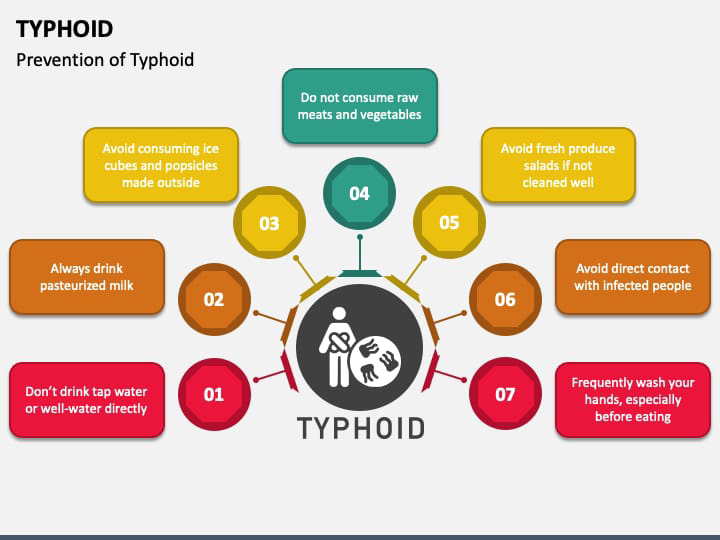Typhoid: What It Is, Causes, Symptoms, and Treatment
Image credit- Google
Typhoid is an illness caused by bacteria called Salmonella typhi. It spreads mainly through contaminated food and water and is most common in places with poor sanitation and hygiene. Typhoid fever can affect anyone, but it is more common in countries where clean water and proper sanitation are hard to find.
What Causes Typhoid?
Typhoid fever is caused by the Salmonella typhi bacteria, which enter the body through the digestive system. Here are the main ways a person can catch typhoid:
1. Contaminated Water:
Drinking water that has been polluted by sewage or waste is one of the main causes of typhoid. If the water isn’t treated properly, the bacteria can survive in it.
2. Contaminated Food:
If food is prepared or washed with dirty water, the bacteria can get into the food. Eating this contaminated food can lead to typhoid infection.
3. Poor Sanitation:
In areas where people do not have access to proper toilets or clean water, the bacteria can easily spread. This often happens in overcrowded areas or places with poor hygiene practices.
4. Carrier Contact:
Sometimes, people who have recovered from typhoid can still carry the bacteria in their system without showing any symptoms. These people are known as carriers. If they don’t wash their hands properly after using the toilet and prepare food for others, they can pass the bacteria on.
Symptoms of Typhoid
Typhoid symptoms usually appear 6 to 30 days after someone is infected. The symptoms can start off mild, but they often get worse over time if left untreated. Some common symptoms of typhoid are:
1. Fever:
A high, continuous fever is the most common symptom. The fever usually rises slowly and can reach up to 104°F (40°C).
2. Weakness:
People with typhoid often feel very tired and weak. This weakness can last for weeks, even after other symptoms go away.
3. Stomach Pain:
Pain or discomfort in the abdomen is another common symptom of typhoid.
4. Headache:
Many people with typhoid experience severe headaches.
5. Loss of Appetite:
A person with typhoid may not feel hungry, and eating can become difficult.
6. Diarrhea or Constipation:
Some people may have diarrhea, while others may experience constipation.
7. Rash:
A flat, red rash called "rose spots" may appear on the chest or abdomen.
If typhoid is not treated, the symptoms can get much worse. In severe cases, it can lead to serious complications like internal bleeding or even death.
How to Get Rid of Typhoid
Typhoid can be treated with proper medical care, but it’s important to act quickly to avoid complications. Here’s what you can do to treat and prevent typhoid:
1. Antibiotics:
Once diagnosed with typhoid, doctors will prescribe antibiotics to kill the bacteria. Common antibiotics used to treat typhoid include ciprofloxacin, azithromycin, or ceftriaxone. It’s very important to take the full course of antibiotics, even if the symptoms improve before finishing the medicine.
2. Rest and Hydration:
Since typhoid causes weakness and high fever, it’s important to get plenty of rest. Drinking lots of water is also essential to stay hydrated, especially if you are having diarrhea.
3. Eat Healthy Foods:
Eating nutritious food can help your body recover faster. Try to eat easily digestible foods like soup, boiled vegetables, and fruit juices.
How to Prevent Typhoid ?
Prevention is better than cure, and typhoid is a disease that can largely be prevented by maintaining good hygiene and being careful about what you eat and drink. Here’s how to reduce the risk of getting typhoid:
1. Vaccination: Getting vaccinated against typhoid is one of the best ways to protect yourself, especially if you’re traveling to an area where typhoid is common. There are two types of typhoid vaccines: an injectable one and an oral vaccine. Both can provide protection, but they don’t guarantee complete immunity, so other precautions are still important.
2. Drink Clean Water: Only drink water that you are sure is safe. This could be bottled water or boiled water. Avoid ice made from tap water in places where the water supply might not be clean.
3. Good Hygiene: Wash your hands thoroughly with soap and water, especially before eating and after using the toilet. Keeping your hands clean can stop the bacteria from entering your system.
4. Eat Safe Food:
Avoid eating raw fruits and vegetables unless you can peel them yourself. Make sure that food is cooked well, especially meat and seafood. Street food, while tempting, can sometimes be unsafe if hygiene is not maintained.
5. Proper Sanitation:
Always use clean toilets, and avoid open defecation. Proper disposal of waste helps prevent the spread of typhoid bacteria.
Conclusion
Typhoid is a serious disease, but it can be prevented and treated with the right steps. By maintaining good hygiene, drinking clean water, and eating safe food, we can reduce the risk of infection. If someone does get typhoid, early diagnosis and treatment with antibiotics can help them recover fully. Remember, prevention is always better than cure, so staying aware and taking precautions is the best way to stay healthy.




